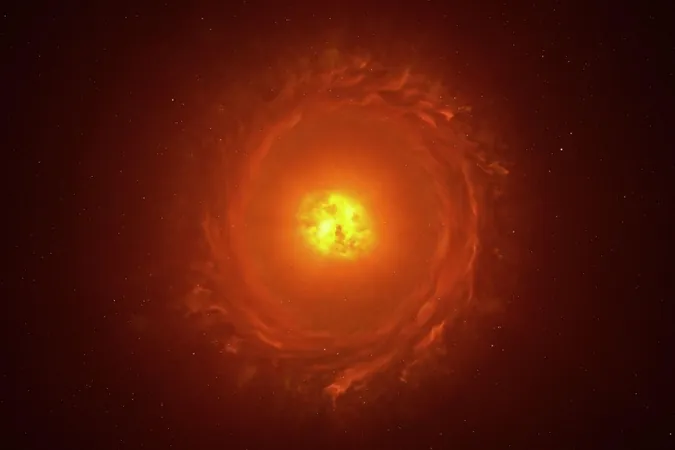
Groundbreaking Discovery: First Close-Up Image of Exploding Star Beyond Our Galaxy!
2024-11-21
Author: Ming
Groundbreaking Discovery
In an astronomical breakthrough, scientists announced on November 21 that they have successfully captured the first-ever high-resolution image of a star beyond the Milky Way. This monumental achievement reveals a dying giant, known as WOH G64, located approximately 160,000 light years from Earth in the Large Magellanic Cloud, a close satellite galaxy to our own.
WOH G64: A Dying Giant
WOH G64 is classified as a red supergiant, currently one of the largest types of stars in the universe, measuring about 2,000 times the mass of our Sun. These enormous stars expand significantly as they approach their inevitable explosive deaths, leading to phenomena such as supernovae.
The Observational Breakthrough
Utilizing a cutting-edge instrument from the European Southern Observatory's Very Large Telescope in Chile, astronomers were able to secure this remarkable image. Dr. Keiichi Ohnaka, an astrophysicist at Andrés Bello National University in Chile, expressed his excitement, stating, "For the first time, we have succeeded in taking a zoomed-in image of a dying star." The image captures a bright but blurry orb, nestled within an oval outline, showcasing the star's decaying brilliance.
Surrounding Cocoon
Dr. Ohnaka further noted the discovery of an egg-shaped cocoon enveloping WOH G64. He commented, "We are thrilled because this may be related to the drastic ejection of material from the dying star before it undergoes a supernova explosion," as detailed in a study published in the prestigious journal Astronomy & Astrophysics.
A Journey Through Time: Observing Stellar Evolution
The team has been meticulously observing WOH G64 over several years. In 2005 and 2007, they employed the Very Large Telescope’s interferometer — merging light from two telescopes — to deepen their understanding of this celestial body. However, capturing a clear image remained elusive until the recent unveiling of a new tool called Gravity, which combines the light from four telescopes for unprecedented clarity.
Star's Dimming
The scientists were astonished to discover that WOH G64 has visibly dimmed over the past decade. "The star has been undergoing significant changes in the last ten years, offering us a unique chance to observe its life cycle in real time," explained co-author Dr. Gerd Weigelt from Germany's Max Planck Institute for Radio Astronomy.
The Dynamic Nature of Red Supergiants
Notably, red supergiants like WOH G64 and Betelgeuse in the Orion constellation are among the most dynamic stars, with any substantial shift potentially heralding their explosive demise. In their final life stages, these stars shed their outer layers of gas and dust over thousands of years — a process that could explain WOH G64's dimming.
The Intriguing Dust Cocoon
The peculiar shape of the surrounding dust cocoon also sparks intrigue; it could be a result of the expelled materials, or perhaps it conceals another star yet to be discovered.
Conclusion
As this exciting exploration into the universe continues, the implications of WOH G64’s transformation could enrich our understanding of stellar life cycles and the beautiful chaos that occurs before a star meets its fiery end. Witnessing this majestic process not only fuels scientific curiosity but also highlights the importance of advanced astronomical technology in unraveling the secrets of the cosmos.



 Brasil (PT)
Brasil (PT)
 Canada (EN)
Canada (EN)
 Chile (ES)
Chile (ES)
 España (ES)
España (ES)
 France (FR)
France (FR)
 Hong Kong (EN)
Hong Kong (EN)
 Italia (IT)
Italia (IT)
 日本 (JA)
日本 (JA)
 Magyarország (HU)
Magyarország (HU)
 Norge (NO)
Norge (NO)
 Polska (PL)
Polska (PL)
 Schweiz (DE)
Schweiz (DE)
 Singapore (EN)
Singapore (EN)
 Sverige (SV)
Sverige (SV)
 Suomi (FI)
Suomi (FI)
 Türkiye (TR)
Türkiye (TR)